In 2023, we’re all familiar with the standard “best practices” of CRO: always use social proof, always reduce form fields, never use image sliders, and so on.
As someone who believes that best practices are merely common practices, I’m always looking to test the tried and true to see how, well, true it really is.
First up? Social proof.
Does it really work as well as we all assume? Why? And more importantly, what’s the best way to implement it?
Table of contents
What is social proof?
Social proof is a phenomenon where people follow and copy the actions of others in order to display accepted or correct behavior, based on the idea of normative social influence.
This term was coined by Robert Cialdini, the same author who presented his six principles of persuasion.
When you’re browsing a landing page and see a testimonial from an industry expert you respect, that’s social proof.
When you’re cruising a pricing page, and you see that an industry giant is already using the tool, that’s social proof.
When you sign up for a demo because you see the tool solved the exact problem you have for a similar company, that’s social proof.
Essentially, it’s borrowing third-party influence to sway potential customers.
Does social proof work? The opinion of growth experts
I asked a panel of conversion and growth experts whether they think social proof is effective. Here’s what they had to say…
Social proof is an important part of executing your landing page strategy.
As customers, we buy products that make us feel good about ourselves, products that change us and make us better.
By using social proof in the form of testimonials, reviews and trust icons you’re helping customers make a decision, feel confident about their choice, and a part of something bigger.
The form of social proof that you choose can instigate different emotional triggers. Planned carefully, you can spark specific emotional triggers that influence customers’ feelings towards their purchase and your business.
Talia Wolf, Founder @ GetUplift.co
As someone who is constantly building and testing landing pages, I always include some form of social proof on them, whether it’s product reviews, testimonials, or even social media share buttons; it’s a no brainer for me.
From a statistical standpoint, social proof has proven to be absolutely worth the time and effort it may take.
For example, a study conducted by the Wall Street Journal focused on how to persuade customers to decrease their energy use in the summer by turning to fans instead of air conditioners.
Consumers were told they would save $54 a month, that it was socially responsible, that it would prevent the release of more than 262 pounds of greenhouse gases monthly, and that 77% of their neighbors had already started using fans.
The majority of individuals who agreed to switch to fans admitted they were doing so because their neighbors already had.
This is a great example of how persuasive social proof can be, particularly when it is prominently placed on your landing and important sales pages.
Mat Carpenter, ShipYourEnemiesGlitter
Social proof is immensely important for landing pages, to the point that it’s one of very few elements I’ve never seen reduce conversion rates in my own tests.
Third-party proof does so much at the same time-sets expectations, gives leads a comparison party to weigh themselves against, reinforces your messaging and substantiates your claims.
Is it always a good idea? There are no absolutes in CRO, but I can say with confidence it’s never NOT present in the baseline comparison variants I create.
It can be executed poorly-for example, choosing sources that don’t reflect your customers, or choosing social proof that seems fake / flimsy.
Joel Klettke, Business Casual Copywriting
Ryan Holiday, author of The Obstacle Is The Way, summarizes it best: “Of course, it depends on what the landing page is for—and what the goal is. But generally, a better way to look at it would be: When do humans not want to see social proof?”
Since the best of the best are still standing by this practice, let’s look at how it’s most commonly used.
6 types of social proof (with examples)
There are six types of social proof that you’ll see, well, pretty much everywhere. Choose one type to use in your baseline variant. You’ll want to choose the type you use based on your specific industry and goal.
1. Case studies
Data-driven, in-depth analysis of the product or service you provided a current customer with. Use this if you’re marketing B2B software, agency services, etc.
In a very meta way, this short-form case study is one of the main ways that folks behind Case Study Buddy showcase the results of their work:
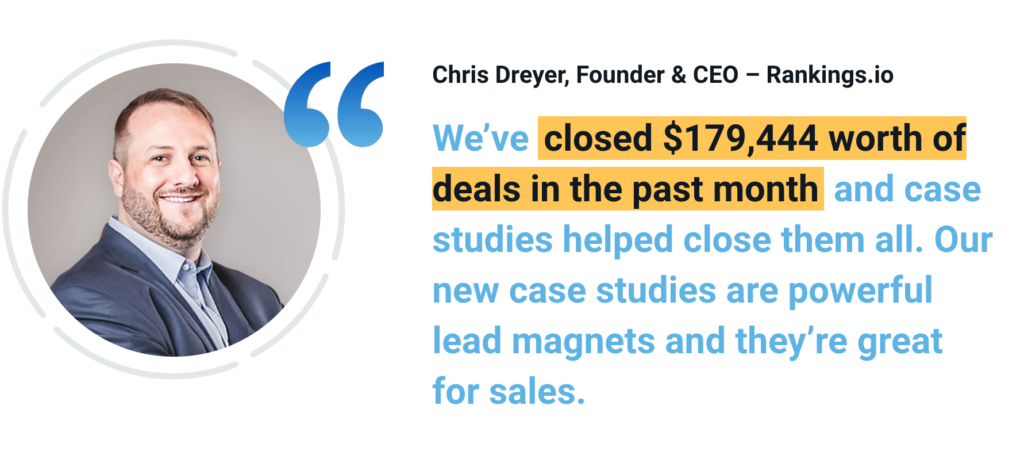
2. Testimonials
Simple, short-form recommendations from happy current customers. These are fairly universally applicable. They can be as effective on a landing page for a free eBook as they can be on a landing page for a $49/month SaaS package.
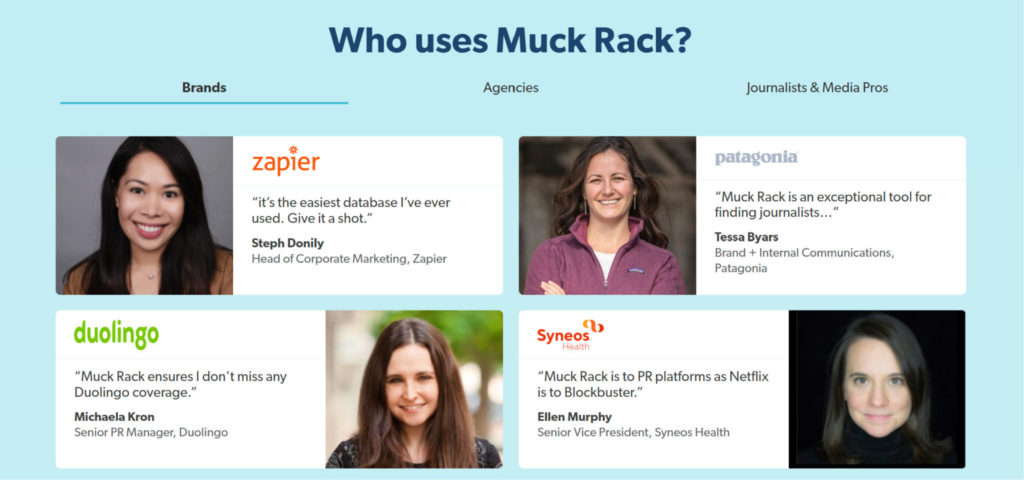
Picture, name, company, role! Don’t forget to legitimize your testimonials. Give them credibility before you use them to give your product or service credibility.
A type of social proof that works over and over again is testimonials. Whether it’s in video or written form, they’ve helped increase the conversion rate of my clients’ landing pages in every case.
When building a landing page, you can say all you want about your offer, but how can you prove what you’re saying is true? Authentic testimonials, preferably with a picture of the person, will take care of that for you. Test it, and I’m sure you won’t regret it.
Raphael Paulin-Daigle, SplitBase.io:
3. Reviews
Think of reviews as testimonials’ more objective cousin. Use these for products that are overly technical or in industries that are crowded and/or highly competitive.
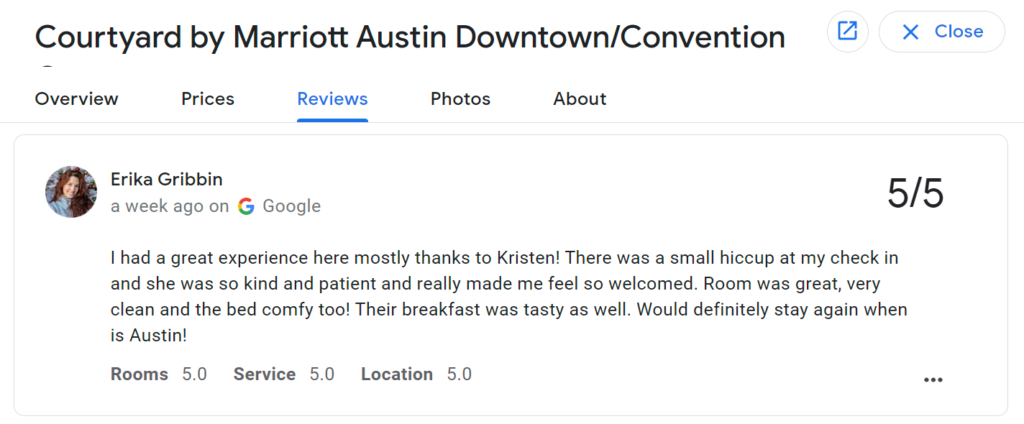
Reminder: Customers aren’t waiting for an invite to review your product or service. Check forums and review sites (like Yelp and Google) regularly to monitor what’s being said about you (and mine for landing page content).
4. Social media
Praise from current customers and/or brand advocates in the form of tweets, Facebook posts, Instagram comments, etc. Save every positive thing people say about your product or service via social media. This type of social proof is most effective for B2C products and services, but that doesn’t mean it never works for B2B.
Social Media Examiner uses social proof on their conference landing page to show how many people are talking about the event year-round.

5. Trust icons
If I had to question one form of social proof in particular, this would be it. TechCrunch covered your Series A funding announcement 4 years ago, so you added their logo to your landing page? You belong to the Better Business Bureau, so you added their logo to your landing page?

Logos and icons might technically be social proof, but they are seriously lacking on the social. What did TechCrunch say about you? What are your BBB reviewers saying? Consider taking a cue from movie and book landing pages, which often include snippets of reviews instead of just publication names or logos.

6. Data / numbers
Customers served, number of invites remaining, etc. A single number can be worth a thousand words. Combine this type of social proof with another. By doing so, you’re saying, “Not only have X people bought our product or service, but here’s how much they are loving it.”
Buffer uses the “X customers served” style social proof to encourage conversions, alongside some other impressive numbers such as blog readers and social followers.

3 innovative social proof examples
I ran a simple A/B test to experiment with social proof a few years ago. My results? A 20% lift without social proof.
The problem with best practices is that once we know something works, we use it over and over again until eventually, it works a little less. And a little less. And a little less.
Raphael agrees…
The ever-so classic press logos are now on almost every website you’ll visit these days. Do they still work? Yes, but probably not as well as they did five years ago. Most visitors are so used to seeing them that this method is starting to suffer from the banner blindness syndrome; it won’t hurt, but you’ll need much more to persuade visitors to take on your offer.
To avoid this issue with social proof, it’s important to break away from the six standard types from time to time. In your next variant, test one of these three more innovative spins on social proof against your baseline.
1. Storytelling social proof
If you’ve constructed your landing page correctly, it’s telling a cohesive story to every visitor. Mat launched ShipYourEnemiesGlitter and used testimonials in an unconventional way. He didn’t talk about the benefits, he didn’t try to address objections. Instead, he used language that supported the story his landing page was telling.
Mat’s story was a little offensive, really funny, and unbelievably effective in terms of conversions (five figure revenue in 24 hours). Very rarely is a screenshot of the “reviews” section of a landing page featured in a Mashable article.

2. Implied social proof
Most social proof you see today is direct. “John Smith of Startup #9389 tried Product X and thought it was amazing.” Sometimes, the most persuasive argument is the one the visitor doesn’t know you’re making.
Take Timothy Sykes, for example. He trades penny stocks (think Wolf of Wall Street) and teaches people how to recreate his success. How does he convince people to register? By implying social proof (note: he uses the standard forms of social proof as well).

In this case, Tim used “do you have what it takes?” style messaging on all of his landing pages. The implication? He doesn’t want you to take his course, you need to take his course.
3. Activity social proof
Every other landing page has “X customers served” style social proof. I can’t deny that it works more often than it doesn’t. However, it can be improved upon. Showing how people have recently used your product or service can go a long way.
“Not only have X customers been served, but these five customers recently used the product or service to do Y.” or “X customers are currently using the product or service right now.” Timeliness adds to your social proof, making it more persuasive and trustworthy. Look at AngelList for example.
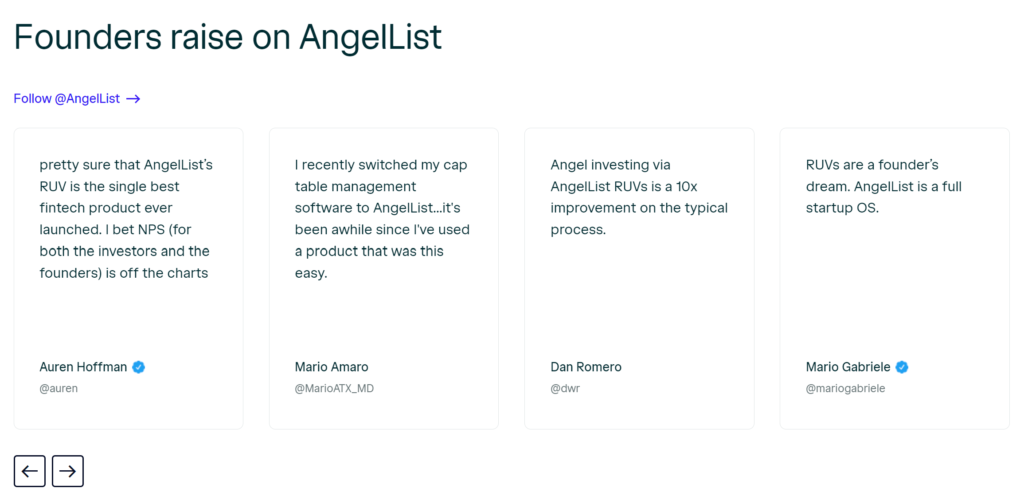
How and when to use social proof on your site
So, now we know that social proof really does work more often than it doesn’t, making it important to most landing pages. Joanna Wiebe, co-founder of Copyhackers and Airstory, thinks that the real question is how and when to use social proof:
“Good social proof is useful for all landing pages because people trust other people more than they trust marketers. But there are caveats, of course.
Every landing page is essentially an argument or a case you’re making to convince the prospect (e.g., a member of a narrow market segment) to choose to opt-in for your freebie or to buy your product, and so every line of copy on the page—including social proof, like testimonials and data points—needs to support that argument.
This means your testimonials need to counter actual objections, not just praise your product or counter non-existent objections.
Your testimonials need to appear at the right part of the argument, not just pop up whenever your designer wants to add a speech bubble or two. They need to be like highly credible witnesses in your case-with photos, full names, professions, and examples of what you’ve done for them-not just marketing copy in quotation marks.
We’ve seen that strong testimonials that leverage future pacing—i.e. help the prospect visualize their improved life post-purchase—are best positioned near a call to action. And groups of testimonials are fantastic on long-form sales pages.
To our surprise, we have not seen testimonials outperform regular copy in headlines, so we tend not to replace critical copy with social proof; instead, we test and recommend testing social proof as supporting copy.”
All social proof is not created equal. It’s not enough to test your landing page with versus without social proof.
It’s less about testing whether or not to include social proof and more about testing how and when you use social proof. Here are a few of the elements of social proof that you should be constantly optimizing:
- The type of social proof. Try the six standard types, the three new spins, and the dozens of other options available. Social proof works, but how you present it can be optimized for more lift.
- The content of social proof. Don’t stop looking for social proof once you have filled the three testimonial slots on your landing page. Always be mining for it so that you can rotate the content and test for the best results.
Try testimonials that address objections, testimonials that talk about the benefits, testimonials that use your core keywords, and so on. - The placement of social proof. We’ve all seen the three testimonials at the bottom of the landing page design. Push back when your designer recommends hiding your social proof away at the bottom every single time. You want to be designing for conversions.
Angie Schottmuller, a well-known growth marketing expert, shared her model for grading the persuasion quality of social proof known as C-R-A-V-E-N-S. Is the social proof credible, relevant, attractive (emotionally), visual, enumerated, nearby and specific?
The social proof psychology principle says that when people are uncertain, they’ll most likely look to others for behavioral guidance. In order to harness this concept for persuasion, marketers must first identify the uncertainties of their customers and then buffer accordingly with appropriate social proof.
Customer words, numbers, and visuals can boost credibility, convey relevance, answer questions, and counter objections. The conversion impact of inspiring confidence is roughly proportionate to the social proof quality and the percent of ‘uncertainty’ friction preventing CTA completion.
In other words, if there’s little uncertainty, social proof will have negligible impact. If there’s notable uncertainty and weak social proof, negative conversion impact is possible. If quality social proof buffers notable uncertainty, get ready for some remarkable conversion impact–in some cases up to 400% improvement.
Angie Schottmuller, Growth Marketing Expert:
Try your social proof in a popup, near the CTA, near the POS, etc. Don’t be afraid to test social proof throughout the funnel, either.
To summarize, you should…
- Use social proof as supporting copy near a call to action or at a point of friction.
- Use social proof to counter objections. What are the reasons someone might not convert?
- Use social proof strategically. General praise for your product or service won’t help you convert as well as targeted messaging will. Use your social proof to support the argument you’re making and the story you’re telling with the rest of the landing page.
- Use social proof to humanize your marketing. A one line testimonial from John Smith is meaningless. Put names to faces, list companies, link to their Twitter pages, etc. Don’t leave out the social.
Brian Massey of Conversion Sciences has some additional insights based on tests he’s run in the past on landing pages and product pages:
People don’t seem to care how many Facebook likes you have or which of their friends liked you. Or, they do care and leave your landing page to be social. Leave social network badges off of landing pages. Save them for the thank you page.
For catalog ecommerce sites, product pages and catalog pages are often landing pages. Ratings and reviews don’t get tested often. They are either implemented or not. If you have them, display the stars and review counts near product images to increase buying confidence. Display the metrics for your product in a positive light. ‘3,413 customers can’t be wrong…’
Brian Massey, Conversion Sciences:
So, which type of social proof works best?
As Joel says, there are no absolutes in CRO. All of the experts in the world can’t tell you, with absolute certainty, which type of social proof to use for your baseline.
Chris Goward of WiderFunnel agrees that you have to test the different types of social proof to figure out what works for your specific landing page audience and goal.
WiderFunnel has done a lot of A/B testing on various social proof tactics on landing pages. On most consumer-facing landing pages, social proof lifts conversion rates in our tests. (Though sometimes it loses, too.)
There are many ways to present social proof and not all work well. Testimonials are overrated, and sometimes social media counts can lift credibility, but only over a critical mass of followers, for example.
Also, the numbers themselves play a role. The order of the digits in follower and customer counts is surprisingly influential.
Most importantly, the response rate to social proof tells us something about the target audience and their persuasional triggers. We’ve seen that some target audiences who are motivated by ‘social inclusion’ triggers respond well. We then show our clients how to build on those insights to influence their other marketing activities.
Chris Goward, WiderFunnel:
However, if you’re looking for some test fodder or if you’re unable to test, we conducted a little study of our own to see if we could identify the factors that make social proof effective.
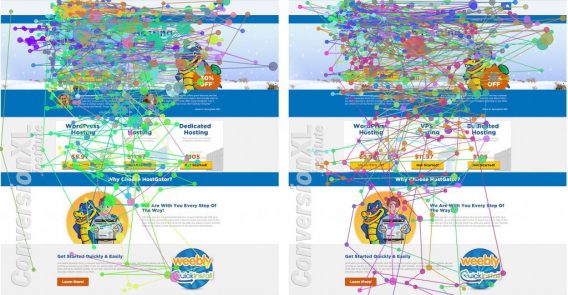
Here’s what we found…
- The different types of social proof didn’t differ significantly in how quickly they attracted users’ attention (average of 8.3 seconds to first fixation).
- People recalled high profile client logos more than low profile logos.
- Testimonials with photos were significantly more effective at generating recall than testimonials with no photos.
- Photos are memorable, but logos and numbers are not.
All in all, that means…
- If you have great testimonials from industry authorities, use them. They’re a huge selling tool.
- That said, all testimonials draw attention. So if your testimonials are just ok, think twice.
- High profile client logos, testimonials with photos, and press mentions are the most memorable.
- Testimonials should always have photos.
- High profile client logos are likely the best social proof to have as they balance high recall with low cognitive load.
How to get your social proof
So, what if you’re just starting out and you don’t have social proof yet? A classic “the chicken or the egg” situation. Oli Gardner, co-founder of Unbounce, says he gets this question all the time. Here’s what he suggests…
One of the most common questions I get is what to do when you don’t have any testimonials. For instance, if you are launching a product that nobody’s used, an eBook that nobody’s read or a service that nobody’s paid for, what do you do to add social proof to your landing pages?
There are four main ways that I suggest going about it.
1. First, be okay with not having any. It’s not the end of the world. Yes, you might get a higher conversion rate with testimonials, but please never fake them. People can smell BS a mile away, so just be patient, or do one of the next three things.
2. Give your product or service away for free. Ideally to influencers in your community or industry. Then ask them for feedback.
3. Instead of having someone talk about your product or service, find a quote from an influencer that backs up the bigger picture concept.
For instance, on the International CRO Day landing page, in the absence of a testimonial, I put a quote from Rand Fishkin saying that conversion rate optimization is really important. He wasn’t talking about the event, but he did say that the subject matter of the event was important, which by proxy makes the event more important.
4. Ask bloggers or reporters to review your product or service.
Oli Gardner, Unbounce:
Conclusion
Trust in online advertising and branded websites dramatically increased over the past decade. According to Nielsen, word-of-mouth recommendations are still the most trustworthy at 84%. As much as 69% of respondents trust advertising on branded websites, and 68% trust consumer opinions posted online.
The good news is that your copy isn’t as untrustworthy as some outdated statistics have led you to believe. Still, you can’t beat good old-fashioned word of mouth.
Finding a new way to package that marketing power via social proof and use it on your landing pages can pay off, if you do it right.
After reading the opinions of the marketing and psychology experts featured in this post, it seems social proof really is that important. But how you use it is what will make or break your landing page.
Move away from the standard uses if you want to move beyond the “banner blindness syndrome” and really tap into the power of social proof.
Working on something related to this? Post a comment in the CXL community!
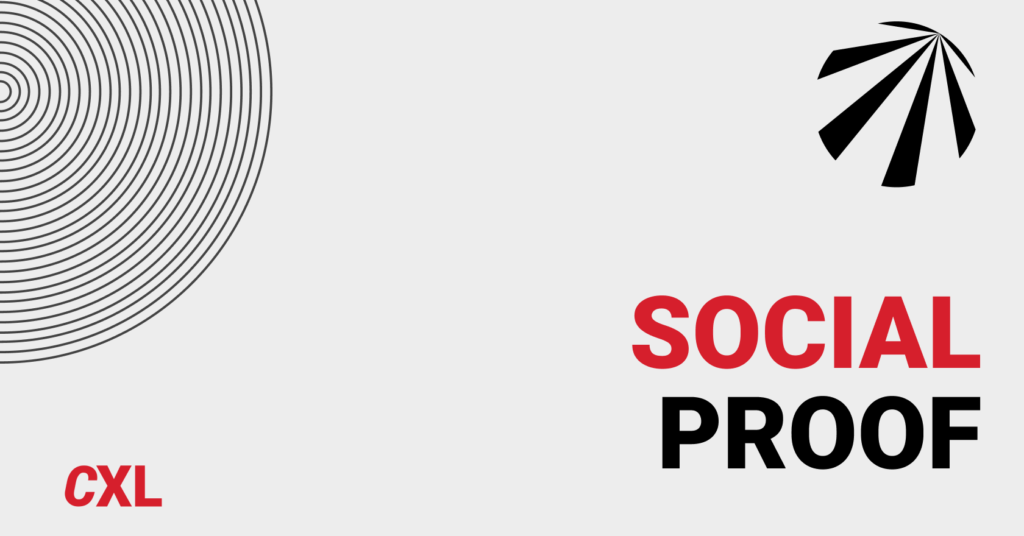




This exactly what I needed. I’m gathering testimonials for my new product and it’s encouraging to see how important social proof is.
Awesome. Glad the article could help!
Just when you thought you were at the end of the article, another expert chimes in with more value. Really enjoyed this one, guys, thank you for adding so many more tools to the CRO toolkit.
Thanks Stephan! Glad you liked it.
A great article Shanelle. I’d like to add my expert opinion to the discussion.
Barilliance just released a new social proof product that enables the presentation of Live! notifications that are created while visitors visit the e-commerce site (e.g. 50 people have bought this product in the last 24 hours or last purchase from this site was 5 minutes ago from someone from New York) . Machine learning algorithms constantly learn and ensure that the most effective messages are presented for each visitor, based on the user’s buying intent and conversion barriers. This means that first time visitors might see a completely different set of notifications from those returning customers will. We have been testing the new product for the last 6 months on leading e-commerce sites worldwide, and the results have been outstanding. Most sites experienced up to 8% increase in conversion rates when we a/b tested the solution against a control group. Read more about Live! http://www.barilliance.com/social-proof-application-for-ecommerce-sites/
Very cool. It’s interesting to see how personalization is advancing and being used to increase conversions. Let me know (@shanelle_mullin) if you publish any case studies!
Very interesting reading Ms Shanelle Mullin! Although, I’m still using G+ and Twitter for as a business tool. There are others that plenty of people have looked at and left it alone not really understanding the concept of social proofing!
@Abby Bandel
Interesting reading about Barilliance. Will most definitely check it out and research it!
Thanks for featuring me in this article Shanelle. Definitely a great read.
I must add that I really like that you addressed the question of what to do if you don’t have any social proof yet. Myself, as well as some clients, have faced this problem on different occasions. Using techniques such as what Oli described, we’ve been able to get pretty good results. His advice is spot-on for the hundreds of people that are probably asking themselves what to do.
Thanks again!
Thanks for contributing, Raphael!
It quickly became apparent that what really needed to be explored was the how. Marketers aren’t testing new types of social proof and they don’t know how to get started with brand new products / services. Oli nailed it.
Great write up Shanelle. Social Proof has since long been accepted as a guaranteed winning technique. However it’s prudent to regularly question the validity of such best practices. Thank you for this :)
Exactly, Sujan! Social proof will likely continue to be impactful, but we need to start experimenting with how we use it if we want to see big results.
Excellent in-depth article Shanelle! It’s great to see other CRO experts discuss the importance of social proof. It’s something that many online businesses do a poor job with job – particularly using bland long text heavy testimonials.
I actually wrote an article last year about how to best leverage the power of social proof on websites, in 10 steps:
http://rich-page.com/website-optimization/skyrocket-your-conversions-with-the-buzzworthy-technique/
Thought you might find it interesting!
Rich Page: Website Optimizer
http://rich-page.com
Thanks Rich! I like the emphasis on gathering the qualitative / quantitative proof and then taking an objective look at what you have / what will actually work.
I particularly appreciated seeing examples of who’s doing this right. Thanks!
If you’re looking for more great examples, non-profit organizations usually use social proof effectively as well. Check out charity: water!
I’m growing my personal brand and I find this article extremely useful. The information provided makes it easier for me to explain why social proof is important to modern business. Thank you Shanelle! :-)
Thanks for this! If you have any specific questions along the way, tweet me (@shanelle_mullin).
Thanks Shanelle for this wonderful piece of information. In this digital age where everyone is engaged on some or the other social media sites like Facebook, Twitter, Linked in, Instagram and such others. The use of social media proof for the growth of the business organizations becomes a totally inevitable scenario. Moreover, customers do rely a lot on these social proofs, testimonials, product reviews and other such data as they come directly from the consumer itself and not from some celebrities that have not actually used that advertised product.
But, it is important to track and analyze the social media behavior of your site visitors so as to advertise your product more effectively. There are various heat map based tools like Crazy Egg, Mocking Fish, Lucky Orange and such others that can easily perform this task for your e- commerce organization.
Good point. It’d be worth looking into how someone arriving from Twitter or Facebook responds to social proof vs. someone arriving from Google or email.
Question regarding Oli’s idea of using a quote from a well-known person that supports your message…this could be perceived as an endorsement by that person, which they may or may not appreciate.
So what would be the best way of going about this…just ask them? Link out to the page where they have the quote? Something else?
I’ve asked Oli to jump in, if he has a second. I’ve done this in the past and haven’t had any issues (so far). As long as you’re not misquoting or intentionally misleading visitors, you should be fine.
Hey Stephan,
That’s a great question, and let me know what you think.
In this case I was actually incorrect in the post. I didn’t use it for a course, and I tend to agree that would’ve been wrong.
Where I did use it was for International CRO Day, and the context is having people talk about CRO in some way.
You can see there is a quote from me and from Rand. http://www.croday.com/
What do you think?
Shanelle, if possible it would be great to update the post to reflect where this appears.
Thanks Oli,
So if I understand you correctly, using this type of “associative” quote is fine when there’s no direct sales call to action, for example, on a blog post, or CRO Day.
If it’s a product or services page, though, probably a good idea to get permission or at least run it by them. Since, let’s face it, you don’t want to link out to that person on your sales page for attribution purposes, that’s a leak ;)
Your quote has been updated, Oli. Thanks for the clarification!
Yeah exactly. And thanks for bringing up the point Stephan – super important to stay classy on this type of thing.
In my personal opinion social proof is the strongest of tools one can use. It’s not coincidence that the current “marketing era” is called “referral marketing”. :)
If you ask me, I would say that Social Proof is sure an important factor for online success. The proof readily helps readers or visitors to trust a brand or blog.
The question of when and how to effectively employ social proof hinges on what the blog wants to achieve. Its a good thing that this blog post has revealed a lot of details within.
For the best results social proof must be timely, targeted and trusted
I left the above comment in kingged.com where this post was found.
Thanks Sunday! What I’ve learned from talking with the panel is that social proof is not inherently trustworthy. You have to give it context to give it credibility. How you use it, where you position it, who you reference, etc. It’s usually the difference between social proof that works and social proof that falls flat.
Hello Shanelle!
This is a great article, but honestly i don’t think social proof has to be “important”. It just has to be beneficial.
So maybe i would write the headline a bit different. For example:
“Is The Power of Your Social Proof Declining? Here’s What You Can Do About It” (or in a statement form)
or even more mysterious..
“Could This Overused Marketing Technique Really Still Work?”
Maybe i’m off with this, that’s just my $0.02!
Social proof taps into very basic human behaviour that allows us to make choices more easily.
For example: if i buy a product on persuasion, i’d be more likely to buy if there was an endorsement from Derek Halpern. No doubt.
However, i do agree with this:
“The problem with best practices is that once we know something works, we use it over and over again until eventually, it works a little less. And a little less. And a little less.”
Like Gary Vaynerchuk says: marketers ruin everything.
I did take a LOT away from this post. I don’t think i’ve ever read a post that goes more in-depth on social proof. The C-R-A-V-E-N-S formula is excellent. Because the right way of implementing it makes all the difference.
Added that to my evernote :-)
LOL, i came across that glitter site through Quora because someone wanted to learn how to write copy in that style. I loved the edgy copy, fits the product well.
Thanks a lot for sharing!
– Jasper
Thanks for the feedback, Jasper. I’m glad you found the post helpful. Mat’s copy for ShipYourEnemiesGlitter was A+, in my opinion.
Hey Alex,
Very informative and interesting post. I was aware about the social proof, but your article give me the deep knowledge of this topic. I think social proof is very important for a business in order to make conversions.
Thanks for sharing this valuable post. Have a great week!
I found your post on kingged.com under social media category.
Hi,
yes, I do think some social proof in the form of testimonials or a case study is to be expected today. Empathy isn’t just a word. People are really on the lookout for some proof of a claim.
When I am interested in something on a website, but do have a bit of doubt, I surely lookout for testimonials. If it sounds honest and authentic, I’m in. Otherwise I move on.
Thanks for reading, Katrin. What signals “honest and authentic” to you personally when you’re on a landing page?
Great question! Is social proof really that important? I deem many newbies asks the same question, a question that needs an accurate and detailed information/answer.
Reading your article, Talia Wolf, Mat Carpenter and Joel Klettke are from different fields. They gave us their opinions, why it is important and it also gives us a hint why we should treat it as important as it should be.
As business owners, social proof is important because it’s such an influential selling tool. While smart marketers know that social proof is the marketing tactic for easing the minds of worried customers
There are different types of social proofs listed above. It is very educational, I must say. Why? We can use these as a way to pull more followers and increase our brand.
Additionally, keep in mind that social proof works best with pictures; it is more influential than saving money.
Thanks for reading! Interesting final statement. Have you ever tested a discount / sale vs. social proof?
Hey Alex,
What a great post about social proof!
Is it still important in regards to landing pages, products, etc… It most definitely is. I’ve actually bought products because of product reviews myself which is one of the social proofs that you mentioned.
I think even more importantly that we all should know How and When to use social proof. Just as Joanna Wiebe was pointing out, for one you want your testimonials to counter actual objections. You don’t want to just give praise to your product or service, but be able to show that there are a lot of benefits from what your testimonials convey despite the fact that of the criticism that comes with it.
And as a blogger, social proof is very important as well. One great example is when an influencer shares your post. With their status and large following, the influence that they have over their “fan base” will definitely make a difference as to how your posts become.
Thanks for sharing Alex and I hope you have a great week ahead!
I found your post on kingged.com under the category of social media
http://kingged.com/is-social-proof-really-that-important/
Joanna is certainly a smart lady! Testimonials tend to be very ra-ra when I think, as she points out, they can be used to counter actual objections and other forms of friction.
Hi Shanelle,
Wow was this a really authoritative Blog post on – Social Proof? For me it was breathtakingly full of value, awesome indeed.
I’ve always know about the value that social proof brings to a site. I’ve always made some sort of attempt of displaying social proof on my sites.
Till I read this blog post, I think I was just – following the herd – without really having a firm understanding about what – Huge value – social proof brings to a website and – How to do it brilliantly.
Having read about the – six standard types social proof – displayable on any site, I realized that I’m missing out on a lot of different ways to deliver appropriate social proof to my site visitors.
The 3 new types of social proof needed several re-reads before I think I understood what was being said. In the end however I think I got them figured out correctly.
I have rarely encountered such an authoritative Blog post, filled with examples and immediately usable content on Social proof.
Now (I think) I’m beginning to wrap my mind around what it takes to reach – Authority Blogger – status.
This Blog post is just superb. Thank you Alex for sharing this on Kingged.
Thanks Ivan! I’m glad you found the article helpful. I’m sure you’ve got them all figured out by now. Have you run any social proof tests since reading?
I liked how you used that feature with the quotes of professionals. It really adds to the value.
Social proof, when used correctly, can improve conversion rates hugely. The one I’m impressed the most is “Storytelling”. I believe that stories have so much power and can sell anything.
“Facts tell, stories sell!”
Thanks for sharing! Have a great day :)
Thanks Viktor! I agree with you on that one. Mat’s version of SYEG was a perfect example; I was glad he agreed to be part of the article.
Thanks Stephan! I am increasingly convinced that social proof is strongly approved of conversions